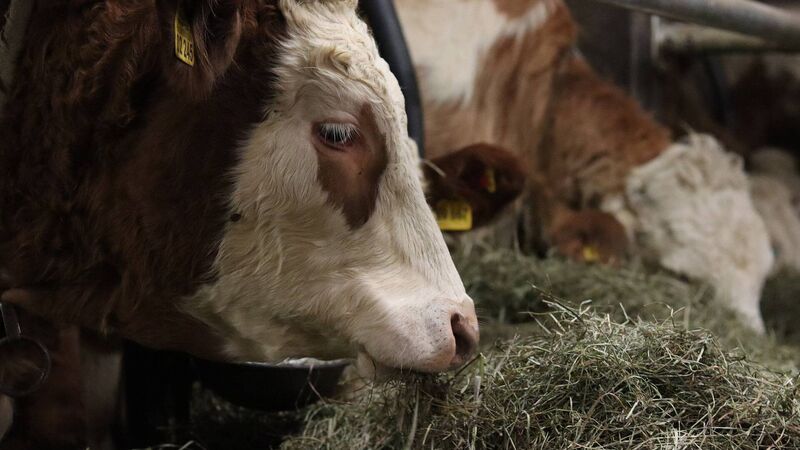After the wet summer, the probability of fluke is higher

Liver fluke treatments vary depending on which part of the fluke lifecycle is targeted.
Before housing, avoid grazing sheep and young cattle in wet areas as much as possible, advised a veterinary expert on a recent Beef Edge podcast.
After the wet summer, the probability of fluke is higher. If sheep are also present on the farm, the likelihood of fluke is even greater. “Sheep are especially susceptible to the immature stage of the fluke, so as the flukes are migrating towards the liver, they can cause massive damage and can actually kill sheep very quickly”, said Dr Natascha Meunier, Beef Health Check Programme Manager with Animal Health Ireland.
Fluke tends to be particularly prevalent in the northwest of Ireland, where 50-80% of herds may still have fluke.
"The thing about fluke is that it’s very farm-specific. You have to have the right conditions for the snail which is the intermediate host on the farm, so it could be that your neighbour doesn’t have fluke, but you do”.
The Beef HealthCheck report records veterinary inspectors’ findings on liver and lung pathology in slaughtered animals, providing information on liver fluke, liver abscesses, and pneumonia. “What we’re seeing for liver fluke in particular, since we began recording it in 2016, is that the liver fluke levels have come down in recent years and are fairly low at an animal level", said Dr Meunier.
Liver fluke treatments vary depending on which part of the fluke lifecycle is targeted. Some are effective only against adult fluke (which take eight to 12 weeks to develop). “If you treat at housing with something that treats immature flukes, then you’re probably covered for most of the housing period”.
However, if treating cattle at housing with a medicine that only targets adult fluke, a follow-up dose effective against immature fluke must be given eight to 12 weeks later.
It can be useful to take faecal samples at housing time, or after a treatment, to ensure all flukes were killed and no longer produce eggs. Or one might analyse faecal samples 12 weeks into housing to determine if any flukes are present.
Rumen fluke are becoming more of a problem. “The odds are fairly good that your listeners will have rumen fluke on the farm”, said Dr Meunier. But its presence does not necessarily call for treatment.
“Most animals can handle the burden of the rumen fluke fairly well, without causing any trouble. For most cases, you probably don’t need to treat, because even if you see rumen fluke eggs in a dung sample sent for fluke testing, those eggs are being produced by adult worms which are sitting in the stomach, and those are well tolerated by the animals. It is immature rumen fluke that can cause diarrhoea and problems with young stock”.
If animals, especially young animals, have diarrhoea and do not respond to other treatments, rumen fluke may be the cause.
As well as fluke, worms, lice and mites may require parasite control, with housing coming around.
“We also might have an issue with lung worm in some cases, and even gutworms and stomach worms, right up until housing. While they’re still on the grass, there’s a possibility they can pick these worms up and they can cause a problem.
"One of the worms that can cause a problem over the winter, one of the stomach worms, is called Ostertagia. That worm goes into a bit of a dormant phase now, as we go into winter, and it can cause a massive problem in the spring”, said Dr Meunier. Hence, correct treatment is vital.
A yellow drench is not effective against Ostertagia, one must use a white or clear drench. Drenching for all worms should be done in the weeks prior to housing, or at housing.
After any medicine, there is a withdrawal period to ensure that food from slaughtered animals does not contain levels of the medicine that exceed the maximum residue limit. “When it comes to your flukicides, depending on which medicine you’re using, this can vary from 13 to 77 days in meat animals”, Dr Meunier explained. The medicine label provides the required information.
“Lice and mites, those external parasites, absolutely love the conditions of housing. We’ve got a nice warm, humid environment, with the animals all close together, and the lice and mites do really, really well”.
Even if animals are treated pre-housing, they may have another outbreak a few weeks in, possibly because they had so much lice that a second treatment is needed. “The eggs themselves from the parasite are not killed by the treatment”, Dr Meunier explained.
“So, three or four weeks later, you may have these eggs. If there are a lot of eggs, they might start hatching and the lice problem starts again”.
It’s important to treat the entire group for lice and mites, because they jump from animal to animal in shared spaces.
Pour-on products work best for biting or chewing mites on the surface. The second type of mite burrow deep and suck fluids and blood and these mites can be treated with injectable products. If there’s a recurring mite problem, sometimes it’s best to get your vet to take skin scrapings to determine what mites are present.












